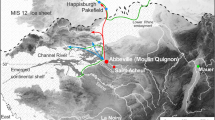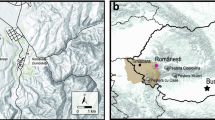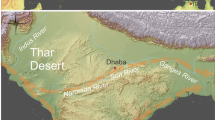Abstract
UNTIL the present decade it was thought that the Early Stone Age of Africa consisted of two industrial complexes, the Oldowan and the Acheulian, the latter succeeding the former after a transitional phase. Well excavated and well dated Oldowan sites are known only from Eastern Africa, although Oldowan sites are reported from North and South Africa, and all known examples are older than 1.5 Myr (refs 1–4). The earliest manifestations of the Acheulian appear approximately 1.5 Myr BP (refs 5, 6) and continue until the Last Interglacial. Leakey has challenged the idea that the Acheulian represents a continuous development of the Oldowan in East Africa1,7,8. At Olduvai in Bed II she recognises two industrial complexes, which are said to represent two distinct cultural traditions, possibly produced by two different hominid taxa. These industries are the Acheulian and the Developed Oldowan. The criteria for defining the Developed Oldowan B have recently been revised and Leakey7 now states that the morphology and technical features of manufacture of bifaces are the principal distinguishing characters between the two industries. The main technological distinction is that the Acheulian biface makers knew how to detach large flakes (>10 cm) while the Developed Oldowan hominids did not. As a result of this revised definition some of the assemblages at Olduvai originally defined as Developed Oldowan B have been reclassified as Acheulian by Leakey7. The problem of the Acheulian and Developed Oldowan can be stated as two alternative hypotheses. (1) Two cultural traditions began in East Africa approximately 1.5 Myr BP, each associated with a distinct social population over an immense span of time; possibly they were of different hominid taxa. Or (2), there was only one cultural tradition (industry), the Acheulian Industrial Complex, beginning about 1.5 Myr BP and marked by highly variable bifacial tools and relative frequency of artefact types; only one hominid taxon during any given period was involved. I have now made a comparative study of the Sterkfontein and Olduvai Gorge Bed II assemblages, which suggests that the Developed Oldowan B industry falls within the Acheulian Industrial Complex and therefore serious consideration should be given to dropping the former term.
This is a preview of subscription content, access via your institution
Access options
Subscribe to this journal
Receive 51 print issues and online access
$199.00 per year
only $3.90 per issue
Buy this article
- Purchase on Springer Link
- Instant access to full article PDF
Prices may be subject to local taxes which are calculated during checkout
Similar content being viewed by others
References
Leakey, M. D. Olduvai Gorge, Vol. 3 (The University Press, Cambridge, 1971).
Chavaillon, J. Proc. VIII Panafrican Cong. on Prehist. and Quat. Stud. Nairobi (in the press).
Isaac, G. Ll., in Earliest Man and Environments in the Lake Rudolf Basin (eds Coppens, Y., Howell, F. C., Isaac, G. Ll. & Leakey, R. F.) (Univ. of Chicago Press, Chicago, 1976).
Chavaillon, J. Bull. Soc. Prehist. Fr. 67, 7–11 (1970).
Hay, R. L. Geology of the Olduvai Gorge (Univ. of California Press, Berkeley, 1976).
Isaac, G. Ll. & Curtis, G. H. Nature 249, 624–627 (1974).
Leakey, M. D. in Proc. IX Cong. U.I.S.S.P., Nice (in the press).
Leakey, M. D. in Background to Human Evolution in Africa (eds Bishop, W. W. & Clark, J. D.) (University of Chicago Press, 1967).
Stiles, D. N. Mila (in the press).
Stiles, D. N. Current Anthropology (in the press).
Author information
Authors and Affiliations
Rights and permissions
About this article
Cite this article
STILES, D. Recent archaeological findings at the Sterkfontein site. Nature 277, 381–382 (1979). https://doi.org/10.1038/277381a0
Received:
Accepted:
Issue Date:
DOI: https://doi.org/10.1038/277381a0
Comments
By submitting a comment you agree to abide by our Terms and Community Guidelines. If you find something abusive or that does not comply with our terms or guidelines please flag it as inappropriate.



